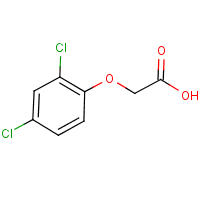2,4-D
Agent Name
2,4-D
Alternative Name
2,4-Dichlorophenoxyacetic acid
CAS Number
94-75-7
Formula
C8-H6-Cl2-O3
Major Category
Pesticides

Synonyms
2,4-Dichlorophenoxyacetic acid; (2,4-Dichloor-fenoxy)-azijnzuur [Dutch]; (2,4-Dichlor-phenoxy)-essigsaeure [German]; (2,4-Dichlorophenyloxy)acetic acid; 2,4-D acid; 2,4-Dwuchlorofenoksyoctowy kwas [Polish]; 2,4-PA; Acetic acid, (2,4-dichlorophenoxy)-; Acide 2,4-dichloro phenoxyacetique; Acide 2,4-dichloro phenoxyacetique [French]; Acido(2,4-dicloro-fenossi)-acetico; Acido(2,4-dicloro-fenossi)-acetico [Italian]; Acme LV 4; Acme LV 6; Agricorn D; Agrotect; Amoxone; B-Selektonon; BH 2,4-D; Barrage; Brush-rhap; Butoxy-D 3: 1 Liquid emulsifiable Brushkiller LV96; Butoxy-D 3: 1 Liquid emulsifiable Brushkiller LV96 [Canada]; Chipco turf herbicide "D"; Chloroxone; Citrus fix; Crop rider; Croprider; De-Pester Ded-Weed LV-2; Debroussaillant 600; Ded-Weed LV-69; Deherban; Dichlorophenoxyacetic acid; Dicopur; Dormon; Dormone; ENT 8,538; Emulsamine; Emulsamine BK; Emulsamine E-3; Envert DT; Esteron 44 weed killer; Esteron 76 BE; Estone; Fernesta; Fernimine; Ferxone; Foredex 75; Green Cross Weed-No-More "80"; Hedonal; Hedonal (the herbicide); Herbidal; Hivol-44; Ipaner; Kwas 2,4-dwuchlorofenoksyoctowy [Polish]; Kwasu 2,4-dwuchlorofenoksyoctowego [Polish]; Kyselina 2,4-dichlorfenoxyoctova [Czech]; Lawn-keep; Macondray; Macrondray; Miracle; Mota Maskros; Moxon; Moxone; Netagrone; Netagrone 600; Pennamine D; Phenox; Phenoxyacetic acid, 2,4-dichloro-; Pielik; Planotox; Plantgard; R-H Weed Rhap 20; Red Devil Dry Weed Killer; Rhodia; Scott's 4-XD Weed Control; Silvaprop 1; Superormone concentre; Tributon; U 46DP; U-5043; Vergemaster; Verton 2D; Verton 38; Vidon 638; Visko-rhap low drift herbicides; Visko-rhap low volatile 4l; Weed TOX; Weed-Ag-Bar; Weed-B-gon; Weed-Rhap A-4; Weed-Rhap B-266; Weed-Rhap B-4; Weed-Rhap I-3.34; Weed-Rhap LV-4-0; Weed-rhap; Weedatul; Weedez Wonder BAR; Weedone; Weedone 100 Emulsifiable [Canada]; Weedone LV4; Weedtrol; 2,4-D [Chlorophenoxy herbicides]; 2,4-D, salts and esters; Acetic acid, (2,4-dichlorophenoxy)-, salts and esters; [ChemIDplus] UN2765; 2,4D
Category
Herbicides, Chlorophenoxy
Description
White to yellow, crystalline, odorless powder. [herbicide]; [NIOSH] White solid; Primary formulations are as amine salt in aqueous solution and as ester in emulsifiable concentrate; [Reference #2]
Sources/Uses
Used as selective broadleaf herbicide with minor applications as a plant growth regulator and fungicide; Active ingredient in approximately 660 agricultural and home use products; [Reference #2] Other agricultural uses include conifer release, to enhance red color in potatoes, for uniform fruit ripening in tomatoes, and to increase latex output in old rubber trees; Was used as a component of the military defoliant Agent Orange; [HSDB] Since 1987, process changes have reduced the chance of 2,4-D being contaminated with chlorinated dioxins; [ACGIH]
Comments
Poisoning by ingestion of large amounts of chlorophenoxy acids has been reported. Patients developed severe metabolic acidosis and multiple organ failure. [EPA Pesticides, p. 95] There is limited positive data that 2,4-D causes birth defects in experimental animals. The data from human studies for skeletal defects is strongly negative. [ATSDR Case Studies # 29] In poisoning cases by ingestion of chlorophenoxy compounds, elevated liver enzymes and rhabdomyolysis with secondary renal failure have been reported; [HSDB] A skin, eye, and respiratory tract irritant; Exposure to high levels may cause nervous system effects; [ICSC] Rapidly decomposed by water; [CAMEO] Shown to increase congenital malformations in mice, rats, hamsters, and sheep, although these effects not reproduced in other studies of mice or rabbits; Most human data pertains to the mixture Agent Orange; [REPROTOX] "TLV Basis" is thyroid effects and kidney tubular damage; In 2-year feeding studies of rats, caused histopathological kidney changes and depressed serum T4 levels (females only) at 45 mg/kg (the highest dose tested); [ACGIH]
Reference Link #1
Biomedical References
Exposure Assessment
Skin Designation (ACGIH)
No
Bioaccumulates
Yes
TLV (ACGIH)
10 mg/m3, inhalable particulate matter
PEL (OSHA)
10 mg/m3
MAK
2 mg/m3, inhalable fraction (including salts and esters)
IDLH (NIOSH)
100 mg/m3
Excerpts from Documentation for IDLHs
Human data: It has been reported that the lethal oral dose ranges from 80 to 800 mg/kg [Dalgaard-Mikkelsen and Poulsen 1962; Dudley and Thapar 1972]. [Note: Oral doses of 80 to 800 mg/kg are equivalent to a worker being exposed to about 3,700 to 37,000 mg/m3 for 30 minutes, assuming a breathing rate of 50 liters per minute and 100% absorption.]
Vapor Pressure
1.4E-07 mm Hg
Lethal Concentration
LC50 (rat) > 1,790 mg/m3
Explanatory Notes
The Guide in the Emergency Response Guidebook is for "Phenoxy pesticide, solid, toxic."
Half Life
Whole body: 220 hours (reduced to 4-7 hours by urinary alkalinization); mean plasma 1/2 life: 12 hours; [TDR, p. 510]
Reference Link #2
Adverse Effects
Hepatotoxin
Hepatoxic (a) from occupational exposure (secondary effect) or (b) in animal studies or in humans after ingestion
Nephrotoxin
Yes
Reproductive Toxin
Yes
IARC Carcinogen
Possible (2b)
ACGIH Carcinogen
Not Classifiable
Diseases, Processes, and Activities Linked to This Agent
Processes
Industrial Processes with risk of exposure: